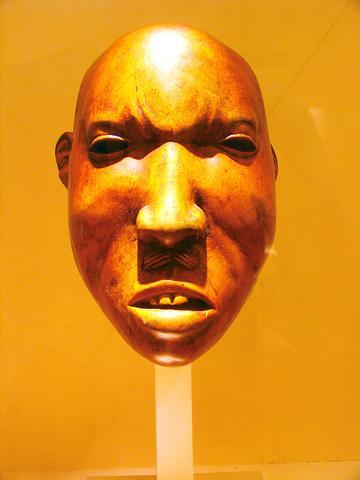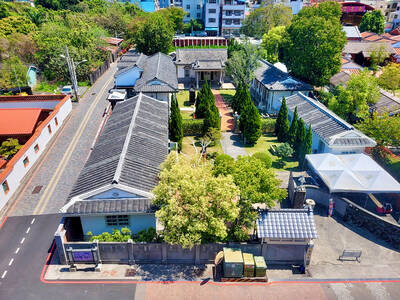The NT$20 adults will pay to view the National Museum of History's current exhibit on art of the Congo is worth it if only to see a single mask. It sits under Plexiglas against the wall in one of the several rooms of this exhibit -- as do dozens of other masks -- but stands out for being the face of a Chinese man.
"A Chinese mask in an exhibition of west African art?" you ask yourself while doing a double-take, looking more closely at the eyes. Yes, it's a Chinese man. And his story is one of the more fascinating for local visitors to an exhibit of artifacts from a world away and lifetimes ago.

PHOTO: DAVID MOMPHARD, TAIPEI TIMES
Dated to the 19th century, the wooden mask is believed to have been made by Yombe or Woyo tribesmen of the northern parts of what is now the Republic of Congo. Another face sits next to him, the mask of a Chinese woman made out in the image of the ideal Congolese beauty. Both are flawless and -- the male figure especially -- seem somehow alive or nearly so. And, in a sense, they were.
Around the corner from them is an excerpt from the book by Gavin Menzies, 1421, telling how Chinese emperor Yongle sent his admiral Zheng He (
While some historians and anthropologists refute much of Menzies' findings, the exhibit offers these masks as evidence that Zheng's expeditions made it at least as far as Africa's west coast. One thing is certain: Regardless of how far Zheng traveled, his were among the last great Chinese naval expeditions. Historians believe it's highly likely, however, that Chinese men sailed aboard the Portuguese ships that later plied a trade between Europe and China.
The masks stand out for another reason: They are among the few objects in this exhibition that offer a narrative to lead visitor's imaginations across the hundreds of years these artifacts encompass. After viewing so many rooms of so many masks, ritual spoons and reliquaries, the mind goes numb without a story to put the items in context. A Congolese hut built in one room offers respite from the rows of statuary, but it lacks the life of that stern-looking Chinese mask. In the ideal place to tell a story of daily Congolese life, the exhibition offers no information as to what goes on inside the hut or outside it.
This is not the first time curators at the history museum have failed to shed light on the dark continent. Another exhibition there a year ago this month, Visiond d'Afrique, was little more than a collection of artifacts set under Plexiglas and bazaar of African-made goods for sale in the expanded gift store. With the current exhibit, at least, the museum has provided cellular handsets that offer recorded information on a dozen or so artifacts. The rest bear only bare-bones placards of the "wooden mask. 19th century" variety.
The exhibit will be taken down and moved to the National Taiwan Museum of Fine Arts on Jan. 21. It will be interesting to see how the curators there decide to present it. It might well be worth the wait.
On a side note, should you decide to spend your NT$20 to see that Chinese mask at the history museum, be sure to step upstairs to take in a separate exhibit of ink works by Gao Yifeng (
For your information :
Congo Kingdom Art -- From Ritual to Cutting Edge runs through Jan. 2 at the National Museum of History (

April 28 to May 4 During the Japanese colonial era, a city’s “first” high school typically served Japanese students, while Taiwanese attended the “second” high school. Only in Taichung was this reversed. That’s because when Taichung First High School opened its doors on May 1, 1915 to serve Taiwanese students who were previously barred from secondary education, it was the only high school in town. Former principal Hideo Azukisawa threatened to quit when the government in 1922 attempted to transfer the “first” designation to a new local high school for Japanese students, leading to this unusual situation. Prior to the Taichung First

Chinese Nationalist Party (KMT) Chairman Eric Chu (朱立倫) hatched a bold plan to charge forward and seize the initiative when he held a protest in front of the Taipei City Prosecutors’ Office. Though risky, because illegal, its success would help tackle at least six problems facing both himself and the KMT. What he did not see coming was Taipei Mayor Chiang Wan-an (將萬安) tripping him up out of the gate. In spite of Chu being the most consequential and successful KMT chairman since the early 2010s — arguably saving the party from financial ruin and restoring its electoral viability —

The Ministry of Education last month proposed a nationwide ban on mobile devices in schools, aiming to curb concerns over student phone addiction. Under the revised regulation, which will take effect in August, teachers and schools will be required to collect mobile devices — including phones, laptops and wearables devices — for safekeeping during school hours, unless they are being used for educational purposes. For Chang Fong-ching (張鳳琴), the ban will have a positive impact. “It’s a good move,” says the professor in the department of

Toward the outside edge of Taichung City, in Wufeng District (霧峰去), sits a sprawling collection of single-story buildings with tiled roofs belonging to the Wufeng Lin (霧峰林家) family, who rose to prominence through success in military, commercial, and artistic endeavors in the 19th century. Most of these buildings have brick walls and tiled roofs in the traditional reddish-brown color, but in the middle is one incongruous property with bright white walls and a black tiled roof: Yipu Garden (頤圃). Purists may scoff at the Japanese-style exterior and its radical departure from the Fujianese architectural style of the surrounding buildings. However, the property